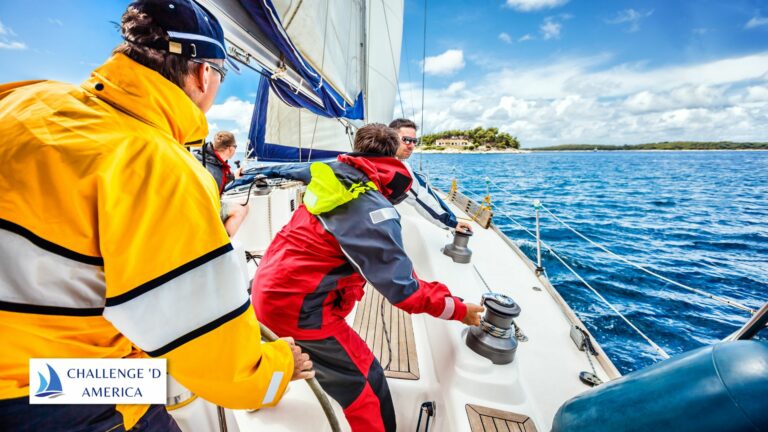How Can Someone Get Crewing Experience On A Sailboat?
As an experienced sailing professional, I’ve been asked many times over the years how someone can get crewing experience on a sailboat.
After all, sailing isn’t just a way to get around, it’s an art. It requires specific skills, knowledge and expertise to get the most out of the experience.
Over time, I have developed a few tips and pointers on how to get started in the rewarding world of crewing on a sailboat. So, if you’re looking for advice on how to get involved in sailing and make the most of the experience, read on!
What Is Crewing?
Crewing on a sailboat is an incredibly rewarding experience. It involves sailing on board a vessel with a professional crew, or even as a part of the professional crew, helping to manage and maintain the boat.
It involves a range of skills, from sail trim and navigation, to manning the helm, and more. Crewing is an essential part of sailing, providing an opportunity to learn more about the sport and to gain experience with different types of sailing vessels. It also helps to build relationships between crew members and with the skipper.
For those looking to gain crewing experience, it is important to understand the different roles and responsibilities on board the vessel.
A typical crew consists of two to four people, with a skipper, who is the leader and overall responsible for the safety of the vessel and its crew; a navigator; a mate; and a deckhand.
The skipper and navigator are usually the most experienced sailors, but the mate and deckhand can also be experienced sailors or novices.
The skipper is in charge of the vessel, providing directions and making sure the crew follows safety procedures. The navigator is responsible for plotting the course and keeping a detailed log of the voyage.
The mate is responsible for sailing the boat, such as adjusting the sails, trimming the sheets and tending to the helm. The deckhand has the responsibility of performing various tasks, such as maintenance, cleaning and preparing the vessel for sailing.
Crewing is a great way to learn more about sailing, as well as developing relationships with other crew members and the skipper.
It is also a great way to gain experience in sailing, as each trip provides an opportunity to learn new skills and practice existing skills.
It is also a great way to build confidence in sailing, as well as gaining a greater understanding of the necessary safety protocols.
Types Of Crewing
As someone looking to gain experience in crewing a sailboat, it’s important to understand the different types of crewing opportunities available.
The first and most common is Racing Crewing, which involves taking part in yacht or dinghy racing. Racing Crewing is a great way to gain experience in the basics of sailing, such as sail trim, handling the helm and crew communication.
This type of crewing is generally very competitive and is often done as part of a team, which requires a high level of discipline and an ability to work together.
The second type of crewing is Delivery Crewing, which involves sailing a boat from one point to another as part of a delivery team.
Delivery Crewing is a great way to learn about navigation, anchoring and lock navigation, as well as the basics of sail trim and helm handling.
This type of crewing also offers the opportunity to experience a wide range of sailing conditions, from light airs to open-ocean crossings.
The third and final type of crewing is Charter Crewing, which involves manning and operating a charter boat for recreational use by paying customers.
This type of crewing involves taking care of the boat and guests, as well as a wide range of sailing skills, from sail trim to navigation.
No matter which type of crewing you decide to pursue, it’s important to remember that crewing experience is as much about learning and developing sea-sense as it is about honing your sailing skills.
How To Get Crewing Experience On A Sailboat
Sailboat crewing experience is a great way to learn the basics of sailing. If you’re interested in gaining sailing experience, there are a few ways you can go about it.
One way to get involved in sailing is to join a sailing club. Many sailing clubs offer both racing and cruising opportunities.
Attending club races provides an opportunity to learn the rules of sailing and to practice sailing maneuvers, while cruising allows you to gain experience in offshore sailing, anchoring, and navigation.
Another way to get sailing experience is to sign up to be a crew member on a boat traveling to a distant port. Offshore sailing trips require crew members who are comfortable with navigation, watch-keeping, and boat-handling skills.
These trips offer an opportunity to gain experience in sailing and seamanship, as well as to meet other sailors. In addition, the boat’s captain can provide knowledgeable advice and guidance to help you improve your skills.
Finally, you can also get experience by working as a paid sailing instructor or crew. A sailing instructor will help teach sailing skills to new sailors, while a crew member will help maintain the boat, prepare meals, and perform other duties as requested.
This type of experience will give you valuable insight into how a sailboat works and how to function as a team onboard.
By gaining experience in these different areas of sailing, you will become a well-rounded sailor who is able to handle a variety of circumstances. With some knowledge and practice, you will be able to confidently and safely crew on any sailboat.
A. Research
Getting crewing experience on a sailboat is an exciting way to explore the world and gain valuable sailing knowledge. Before setting off, it is important to research the sailing routes and the vessel you’ll be travelling on.
Some essential areas to research include the captain’s experience, the crew’s qualifications, and the vessel’s stability and seaworthiness.
When researching a potential captain, look for someone with considerable sailing experience who has sailed a similar route before.
It’s also important to make sure that the vessel is well equipped with up-to-date navigational equipment, and has adequate safety protocols in place.
It’s essential to understand the amenities available onboard, such as sleeping arrangements, kitchen facilities, and freshwater and fuel stores.
The crew should have a basic understanding of sailing, including knowledge of sail trim, navigation, helming, and anchoring.
It’s also important to check whether the vessel has a VHF radio, as well as the relevant licences, insurance and certification.
By conducting thorough research prior to accepting a position, you can ensure your safety and have confidence in the expertise of your captain and crew. This in turn will ensure that your sailing experience is a safe and enjoyable one.
B. Networking
When it comes to getting crewing experience on a sailboat, networking is another key resource. Reaching out to the sailing community to build connections and find out what opportunities are available can be extremely beneficial.
First, it is important to be able to demonstrate your sailing knowledge and skills. The best way to do this is to get involved in sailing events and races, as well as joining local sailing clubs.
Another way to network for sailing opportunities is to contact sailing organizations, such as the US Sailing Association (USSA) or your local sailing authority.
Visiting boatyards, marinas, and other sailing-related businesses can be a great way to make connections and find out who is looking for crew.
Social media is also an excellent tool for connecting with people who are involved in the sailing community. Joining Facebook sailing groups and following influencers in the sailing world, such as professional sailors and boat builders, can expand your network and help you land that perfect crewing position.
It is also wise to create a professional resume outlining your sailing experience, certifications, and qualifications. Making yourself visible in the sailing world and putting yourself out there can open up a world of opportunities.
C. Training
Training is an essential part of crewing on a sailboat. Knowledge of basic sailing techniques, safety procedures, and seamanship is a must for anyone looking to join a sailboat crew.
If you have no prior sailing experience, the first step is to take a basic sailing course from a sailing school or a licensed sailing instructor. This will provide you with the foundational skills needed to sail safely and confidently.
Once you have a basic knowledge of sailing, you can then take more advanced courses to hone your skills and gain more experience.
These courses can range from courses on sailing navigation and weather forecasting, to courses on boat maintenance and repair. There are also courses that specialize in racing tactics, which are invaluable for those looking to join a sailboat racing crew.
For those with prior experience sailing, or who are looking to further their knowledge, there are also courses that focus on skills such as celestial navigation, advanced sail trim, and sailboat racing tactics.
Many of these courses are offered by international sailing organizations, certifying agencies, and even private sailing schools.
It is important to note that some of these courses are not available in all countries, so it is best to research which ones will be available in your area.
D. Finding A Boat
If you have decided to pursue sailboat crewing experience, you first need to find a boat. Fortunately, there are a variety of ways to do this.
The first and most obvious way is to simply ask around your sailing community or local marina. You can also search for boats online or through syndicates, which are groups of people who share ownership in a boat. The advantage of joining a syndicate is that it is often a more cost effective way to gain access to a boat.
If you don’t have access to a boat, you can also look into day charters or racing charters, which allow you to join a crew for a day or a race. This is an excellent way to gain experience without committing to a full season.
You can also look into sailing clubs, many of which offer volunteer positions that allow members to gain sailing experience.
Finally, there are many online job boards such as Crewfinders, which allow you to search for crewing positions. This is an especially good option for those who have limited sailing experience and are just getting started.
No matter what route you choose, it is important to do your research and make sure that the boat and crew are reputable and safe. Ask to see the boat’s paperwork and make sure the crew has the appropriate qualifications and experience.
With the right approach, you can easily find a sailboat and gain the experience you need to pursue a career in sailing.
Summary: How Can Someone Get Crewing Experience On A Sailboat?
Getting crewing experience on a sailboat can be a great way to enter the sailing world. To start, individuals looking to gain sailing experience should seek out crew opportunities from local sailing clubs, sailing schools, and boat owners.
Once an individual has been accepted as a crewmember, they should make sure to stay flexible and be willing to take on any role assigned.
To get the most out of their experience, crews should be proactive, ask questions, and take initiative.
Additionally, having basic sailing knowledge and understanding terminology can be beneficial. With hard work, dedication, and a supportive crew, individuals can gain valuable experience sailing aboard a boat.
FAQs
What Qualifications Are Necessary To Get Crewing Experience On A Sailboat?
If you are looking to gain experience crewing on a sailboat, there are some important qualifications you should have.
First and foremost, you should have a basic knowledge of sailing and the associated terminology. You should also have some experience in the type of sailing you plan to do, and be able to demonstrate your knowledge and ability.
If you plan to sail offshore, you should have a valid sailing certificate, such as the International Certificate of Competence (ICC), or a local equivalent.
This certification is required to ensure that you and the other crew members are able to operate the vessel safely, and understand the regulations of the sea.
In addition, you should have a working knowledge of sail trim, sail handling, and navigation. Knowing how to properly set the sails, deploy the spinnaker, and using basic navigational skills is essential for offshore sailing.
It is also beneficial to have some experience with maintenance and repairs. You should be able to troubleshoot basic issues and fix them on your own, or with the help of other experienced crew members.
Finally, it is important to have a positive attitude and the ability to work as part of a team. Crewing on a sailboat requires you to work together with others to complete tasks and make decisions. Having a good attitude, and the ability to get along with others, is a must.
By having the proper qualifications, you can gain valuable experience crewing on a sailboat, and create lifelong memories.
What Type Of Sailing Experience Is Required To Get Crewing Experience On A Sailboat?
The type of sailing experience required to get crewing experience on a sailboat will depend on the level of sailing you are looking for.
For basic crewing, you’ll need some sailing experience and a basic understanding of sailing terminology, such as points of sail, tacking, jibing, trimming the sails, and understanding wind direction and speed.
You should also have a good knowledge of sailing safety and seamanship, such as how to tie knots, handle lines, launch and recover a dinghy, and how to use navigational aids.
For more advanced crewing, you’ll need a much deeper knowledge of sailing, such as sail trim and sail handling, sailboat racing tactics, and navigation skills.
You’ll also need to be able to work quickly and efficiently while aboard a sailboat, and be able to work as part of a team.
In addition to sailing skills and knowledge, sailor’s should be physically fit and able to endure long days at sea, and have a positive attitude and be willing to learn. You should also make sure you have the proper safety gear, such as a life jacket, harness, and foul weather gear.
Overall, the type of sailing experience required to get crewing experience on a sailboat depends on the level of sailing you are looking for and the requirements of the boat you are sailing on. No matter what level of experience you have, having the proper skills, knowledge, and attitude will help you get crewing experience on a sailboat.
Are There Any Organizations Or Programs That Offer Crewing Experience On A Sailboat?
Yes, there are several organizations and programs that offer crewing experience on a sailboat. Many sailing schools, sailing clubs, and sailing charters offer crewing experiences or sailing courses.
Additionally, some yacht clubs, coast guard auxiliaries, or other sailing organizations may provide opportunities for crewing experience.
For those looking to get their feet wet in the sailing world, many sailing schools are a great place to start. Sailing schools offer courses in both basic and advanced sailing and many of these courses include hands-on crewing experience.
From learning the basics of sailing and navigation to learning how to trim sails and reef, sailing schools are a great way to get your sea legs.
If you’re looking for a more advanced crewing experience, there are a variety of sailing charters and yacht clubs that offer longer-term crewing opportunities.
Many of these charters offer multi-day or week-long excursions that give you the chance to experience life on the open seas.
Yacht clubs may also offer crewing experience, allowing members to join vessels for a variety of events throughout the year.
Finally, for those looking to gain crewing experience for a specific purpose, such as a sailing certification or to join a regatta, there are a variety of programs available. Many of these programs offer a hands-on experience that can be tailored to your individual needs.
No matter what your goals are, there are plenty of organizations and programs available that offer crewing experience on a sailboat.
With some research and dedication, you can find an opportunity that fits your needs and experience the thrill of sailing the seas.
What Are The Benefits Of Getting Crewing Experience On A Sailboat?
Crewing experience on a sailboat has a multitude of benefits, both for the novice and experienced sailor. Not only will you gain invaluable knowledge and skills in navigation, sailing technique, and seamanship, but you will also learn the ropes of teamwork and communication on a boat.
For novice sailors, having crewing experience on a sailboat provides an opportunity to gain knowledge and hands-on experience in a controlled environment.
With the guidance of an experienced skipper and crew, you will learn sailing terminology, safety protocols, and the ins and outs of sailing.
Additionally, you will learn how to read the wind and sea conditions, how to navigate using the stars, and how to use a chart and compass.
For experienced sailors, crewing aboard a sailboat provides an opportunity to hone their skills and become more confident in their abilities as a sailor.
They can learn more advanced techniques, such as how to sail in heavy weather, how to properly read wind and sea conditions, how to trim sails, and how to handle a boat in a variety of different conditions.
Regardless of skill level, crewing experience on a sailboat is a great way to gain a better understanding of sailing and the ocean.
There is nothing quite like being out on the open waters, learning from experienced sailors and gaining the knowledge and skills necessary to become a better sailor.
What Are The Risks Associated With Getting Crewing Experience On A Sailboat?
There are a few risks associated with getting crewing experience on a sailboat, most of which are related to the potential for danger or injury.
The first risk is the risk of falling overboard. This is especially common in rough weather or when sailing in unfamiliar waters.
In such cases, crew members should take extra care to remain aware of their surroundings and avoid any sudden movements that could lead to an overboard situation.
Another risk is getting exposed to the elements. While sailing, crew members are exposed to a range of environmental conditions, from extreme heat to cold, high winds, and heavy rain. This can put a strain on the body, especially if the crew is not adequately prepared or protected.
The third risk is the risk of equipment malfunction. Even the most experienced sailor can experience equipment failure or malfunction, which can lead to dangerous situations.
It is important to ensure that all equipment is in good working order and that the crew is familiar with its use and maintenance.
Finally, there is the risk of injury. Injuries can occur while onboard a sailboat due to falls, contact with sharp objects, or even when dealing with heavy equipment.
To minimize the risk of injury, crew members should always wear appropriate clothing and safety gear, and be mindful of their environment.
Overall, getting crewing experience on a sailboat can be an incredibly rewarding and exciting experience, but it is important to be aware of the risks involved.
By taking precautionary measures and being aware of your surroundings, you can help to reduce the risk of harm and make sure you get the most out of your sailing experience.







